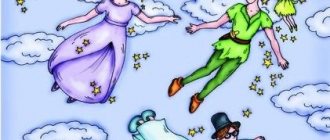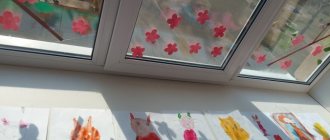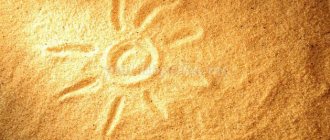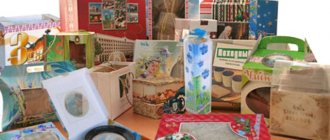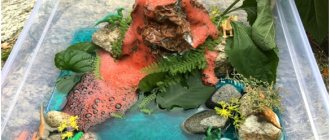Abstract of the GCD "Experiments with flour"
Municipal state educational institution
“Cherepetskaya Secondary School Central District named after. N.K.Anosova"
Summary of educational activities for the cognitive development of children from the “Scarlet Flower” group “Experiments with flour”
Prepared and conducted:
teacher Pechenkina Oksana Sergeevna
2019
Target:
- Introducing children to the properties of flour through children's experimentation.
Tasks:
Educational objectives:
- Expand and clarify children's knowledge about grain crops.
- Introduce the properties of flour.
- Continue to develop in children the ability to foresee the consequences of actions.
Developmental tasks:
- Develop a cognitive interest in experimentation and the ability to draw conclusions.
- Develop auditory, visual, tactile analyzers.
- Develop attention, thinking, memory.
Educational tasks.
- Develop partnerships in children when working in pairs.
- Cultivate respect for the work of adults and respect for bread.
Preliminary work:
- View the presentation “Cereal Crops”;
- Excursion to a bread store, kneading salt dough.
Vocabulary work:
bakery products, confectionery products, ingredients, grains sieve.
Demo material
:
- Preparation for a crossword puzzle.
- Pictures of fields with grain crops.
- Exhibition of flour products, sugar, yeast, wheat, peeled and non-peeled oats.
Handout:
- A flat plate, a magnifying glass, a spoon, a jug of water, two napkins, deep bowls - a set for two children.
Equipment:
Coffee grinders (Manual and electric).
Progress of the lesson.
Organizing time. There is a crossword puzzle with an encrypted word on the board.
Educator
: Guys, I received a strange letter. There are four empty cells in the letter - an encrypted word. And only by completing certain tasks will you help me find out what is written in it.
The first cell contains the letter that is hidden in the word PASTA and is in first place. (M) In the second cell there lives a letter that is hidden in the word BULKA and is in second place. (U) In the third cell there lives a letter that is hidden in the word BUBLIK and stands at the end of the word. (K) In the fourth cell there lives a letter that is hidden in the word BATON, and is in second place in it. (A). Let's read what word we got! (FLOUR)
Educator:
What do you think flour is for?
Children's answers:
(In order to bake bread, loaf, rolls, cookies)
Educator
: Well done! You all answered correctly. Flour is needed to bake bakery, confectionery, and pasta products.
Practical part at the tables:
Educator
: Today we will find out what properties flour has. Look, there are glasses of flour on your tables, carefully smell the flour. Does flour have a smell? (Yes, flour has a smell, but it’s something special) - Flour has a smell.
Pour flour from a glass through a strainer into a plate. What happens to the flour? (Sprinkles) - Free-flowing flour.
Take a pinch of flour and tell me how you felt? What kind of flour? (Light, soft, fluffy, airy) – Flour – soft, fluffy.
Level the flour in the plate by moving the tray slightly to the sides. Try drawing something on the flour with your finger. – It turns out you can write and draw on flour.
Place a spoonful of flour in a glass of water and stir gently. What happened to the flour? (Dissolved) - Add two more spoons. Stir and determine what happened? (It turned out to be a liquid dough) - The mixture became viscous, sticky, dense, thick.
Thus, the dough for baking is kneaded.
In order to bake fluffy buns, various ingredients are added to the dough: butter, salt, sugar, eggs, yeast. – Now, let’s add a little sugar and yeast to one of your glasses. And put in a warm place one glass with yeast and sugar, and the second with only flour. And let’s wait a little (put the blanks on the battery).
Physical education minute.
While our dough is rising, I suggest playing.
Didactic exercise with a ball. The presenter, asking a question, throws the ball to the child, who returns the ball with the answer, etc.)
Where did the bread come from? - from the shop. How did you get into the store? - from the bakery. What do they do in the bakery? - bake bread. Of what? - from flour. What is flour made of? - from grain. Where does the grain come from? - from an ear of wheat. Where does the wheat come from? – grew up in the field. Who sowed it? - grain growers.
- Guys, what do you think flour is made from? (from grain) - What grain is flour made from? (Wheat, oats, barley, rice, corn, rye, buckwheat). - That's right, guys! Many grain crops
and various products are baked from them.
Name what bakery products you know. (Bread, loaf, etc.), confectionery, pasta.
Well done, you know a lot about bread products. I suggest you conduct an experiment today, sit down at your desk and look at what is on the tables.
You have different grains in your plates. Let's look at them with a magnifying glass and determine what they are called (oats, wheat, rice, corn, buckwheat). Today we will try to make flour from oats and wheat ourselves, using manual and electric coffee grinders. (The teacher, with the help of the children, pours beans into coffee grinders and demonstrates the process of crushing the beans, then pours the resulting flour into a transparent container)
Let's see, guys, what kind of flour we got. (Children's answers) - Let's compare it with store-bought flour. (Children's answers)
- Why isn’t she white? Before making white flour, the grains go through several stages of sorting and purification; and only after that the grains produce pure white fluffy flour, the kind we buy in stores. In our country, the most common bread is wheat and rye. Coarse rye bread is especially useful; it contains many microelements necessary for our body.
It’s not for nothing that people have many proverbs about bread, and our children will remind us of them today: Children tell proverbs
Bread is the head of everything. Bread and water are healthy food. It's a bad lunch if there's no bread.
Educator
: For bread to come to our table, many people work on it. These are tractor drivers, combine operators, grain growers, millers, bakers, drivers, sellers, etc.
Take care of our bread, don’t waste your bread! Respect our bread
Don't play with bread. You can't throw away bread! Take care of your bread, Friends!
Physical education minute:
Today I want to offer you the game “The Sea Is Worried Once,” which is already familiar to you, but the figures in this game will not be marine at all. Everyone come out in a circle and listen carefully to which figure needs to be drawn (combine operator, baker, grain grower, tractor driver, driver).
Educator.
Guys, today we conducted experiments, talked about bread, played, and now let’s all make a Spikelet out of salted dough together. Come and take the dough pieces, prepare your workplace, prepare yourself (put on aprons) and get to work.
Children do the work themselves. At the end of the work, the teacher organizes an exhibition of products on a common tray.
Educator:
Look, guys, how many ears of corn we got, they are all different. We'll leave them to dry. And now it’s time to remember our experiment with the dough. Take your glasses and place them on the table. Compare, where is there more dough? Why do you think? (children's answers).
Educator:
How many new and interesting things we learned about flour today. Let's remember what properties flour has? (children's answers). What needs to be done to bring bread to our table? (children sum up the lesson by talking about bread).
During the day, the teacher organizes educational games “Bread Store”, “Bakery”. After drying, the salt dough spikelets are painted and varnished and used for games.
